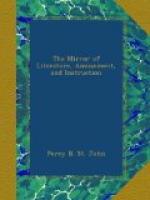“A perfectly original book of Cookery,” says Mrs. D. “would neither meet with, nor deserve, much attention; because, what is wanted in this matter, is not receipts for new dishes, but clear instructions how to make those already established in public favour.” This reasoning is very just, for none but the most thankless of gourmands, or the gourmet who wished to affect the sorrows of the great man of antiquity,—would sit down and weep for new worlds of luxury. Good cookery is too rarely understood and practised to justify any such wishes; and to prove this, let the sceptic go through Mrs. Dalgairns’s 1,434 receipts, and then “tire and begin again.” Our respected editress assures us that “every receipt has either been actually tried by the author, or by persons whose accuracy in the various manipulations[3] could be safely relied on.”
[3] This is an unlucky word
for a cookery book. Why not say
operations?
Mrs. D. Mrs. D! you have not escaped the scientific
mania
that is mounting from area to attic throughout this
country.
Such a term as manipulation sounds well enough
in Mr.
Brande’s
laboratory at the Royal Institution, but would be quite
out
of place in the kitchen of either of the hotels in
the same
street.
A footman might as well study the polarization of light
whilst
cleaning the drawing-room windows.
From a table of contents we learn that among them there are the following methods:—
Soups 105 Fish 115 Beef 70 Mutton 31 Veal 60 Gravies, Sauces, &c. 104 Puddings, Pies, and Tarts 263 Creams, Custards, &c. 134 Cakes and Preserves 182
—what more can mortal man desire, “nay, or women either.” Appended to them is much valuable information concerning the poultry-yard, dairy, brewery, kitchen-garden, bees, pigs, &c. so as to render this Practice of Cookery a truly useful and treasurable system of domestic management, and a book of matters-of-fact and experience. The subject is too melting—too tempting for us to resist paying this tribute to Mrs. Dalgairns’s volume.
* * * * *
“CLOUDS AND SUNSHINE.”
An appropriate April book, too controversial for extensive quotation in our pages, as the enumeration of its contents will prove. They are half-a-dozen gracefully written sketches, viz. the Gipsy Girl, Religious Offices, Enthusiasm, Romanism, Rashness, and De Lawrence. Half of these papers, as will readily be guessed from their titles, bear upon “the question,” and are consequently, as the publishers say, “not in our way.” We are, nevertheless, proud to aver that the sentiments of these chapters are highly honourable to the heart of the writer as they are creditable to his good taste and ability. He is, to judge from his book, a good man, one who is not so willing as the majority of us, to let his philanthropy remain




